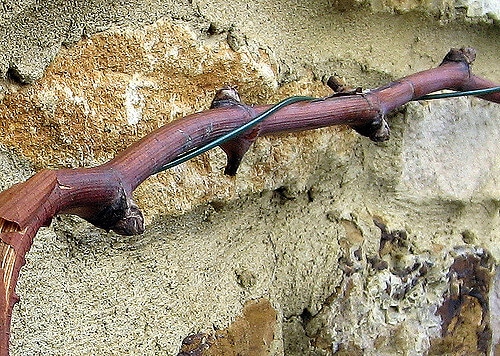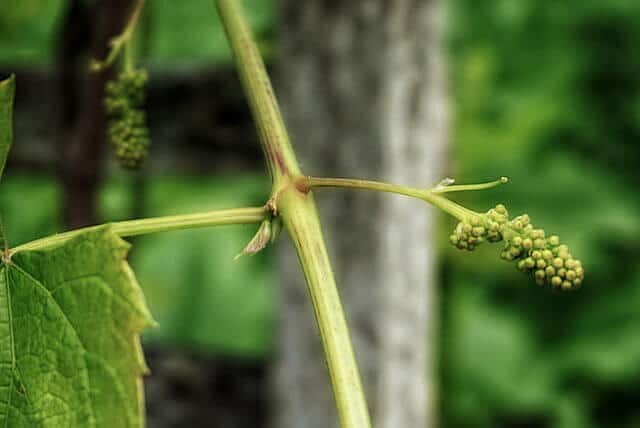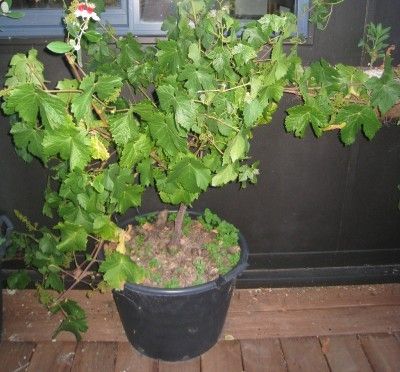Grape vines do surprisingly well in pots. They’re adaptable plants and, properly maintained, require relatively little space.
There are a huge number of varieties for both cold and warm climates, likely because of the huge wine-growing industry. If you want to grow grapes in containers, then I highly recommend you do. They’re perennial, so there’s no need to re-pot every year and yields can be high.
Grapes are also a good candidate for indoor growing. If you have a greenhouse or particularly bright window, they are a good choice.
The type of vine you choose is very important. The general care tips in this article are good for all climates, but it’s important to start by choosing the right type of vine (bare-root or potted). Pruning is the other main concern. Even though grape vines in pots won’t grow as fast as plants in the ground, pruning them is pretty much the same. There will just be less to do and a few slight variations.
Growing juicy grapes at home may seem daunting, but with the right variety and care, you can have success cultivating grapes in pots. Whether you have a small garden or simply want to grow grapes on a balcony or patio, container grape growing allows you to produce clusters of tasty fruit
Choosing Grape Varieties for Containers
While grape vines can sprawl across acres of vineyard, they adapt surprisingly well to life in a pot. The key is selecting compact grape varieties suited to container culture. Consider the following factors:
-
Climate – Grape vines range from cold hardy to subtropical Choose a variety suited to your planting zone,
-
Size – More dwarf, early ripening grapes varieties fit containers best. Look for naturally smaller vines.
-
Flavor – Table grapes for eating fresh and wine grapes differ in taste. Decide which you prefer.
-
Seedless – Seeded grapes take more energy to produce, reducing yields. Seedless varieties like Somerset are better.
-
Self-pollinating – Since pots limit cross-pollination, self-fertile grapes avoid reduced fruit set.
Popular pot-friendly grape varieties include:
-
Table grapes – Somerset, Mars, Hope
-
Wine grapes – Pinot Noir, Cabernet Sauvignon
-
Cold-hardy – Valiant, King of the North
Planting Grape Vines in Containers
Grapes grow well planted from spring to fall. Follow these tips for planting success:
-
Use a 15+ gallon plastic or wooden container with drainage holes. Dark colors absorb too much heat.
-
Fill with a well-draining potting mix amended with 1/3 grit or perlite for aeration.
-
Sink a strong trellis in the pot for support. A teepee shape works well.
-
Plant a bare root or potted grape vine near the base of the trellis. Prune any damaged roots.
-
Water well after planting. Grapes like consistent moisture during establishment.
-
Mulch around the base to retain water. Leave space between mulch and the trunk.
Caring for Container Grown Grapes
A few adjustments to normal grape care keep potted vines thriving:
-
Water whenever the top few inches of soil become dry. Grapes are drought sensitive.
-
Fertilize every 2-3 weeks during the growing season with a balanced fertilizer.
-
Prune annually to limit vine size. Cane pruning works best for container plants.
-
Repot in fresh soil every 2-3 years as nutrients decline. Do this in early spring.
-
Move containers to a sheltered spot for winter. Mulch the soil if pot bound.
-
Monitor for pests like Japanese beetles that can ravage grape leaves.
Maximizing Grape Harvests in Pots
Producing good yields from container grapes requires some pruning finesse:
-
Allow no fruit the first year. Focus energy on root development instead.
-
In year two, permit just a few small bunches to form.
-
Beginning year three, aim for 3-5 clusters per plant. Snip off extra flowers.
-
Reduce leaf cover around grape bunches to increase light exposure and ripen fruit.
-
Support heavy clusters with netting as needed to prevent breaking branches.
-
Test grapes for sweetness before harvesting. Flavor peaks in early fall.
Troubleshooting Common Container Grape Problems
Watch for these potential issues threatening potted grapes:
-
Yellow leaves – Usually signals iron deficiency. Supplement with chelated iron.
-
Few grapes – Extreme heat or over-pruning limits fruit. Offer shade and reduce pruning.
-
Leggy growth – Insufficient light causes stretching. Move container to maximize sun exposure.
-
Wilting – Drooping leaves or vines indicate under watering. Increase watering frequency.
-
Moldy fruit – High humidity and dense foliage cause mold. Improve air circulation through selective pruning.
Enjoying the Fruits of Container Grape Growing
Once established, grape vines in pots produce abundant fruit for 15-25 years or longer. Harvest grapes at peak ripeness to enjoy out-of-hand, or use the bounty in jams, juices, wines, and raisins. With the right care, grapes grown in containers let you reap homegrown goodness, even in small spaces.
Good grape varieties for pots
The key thing to remember is to get a self-pollinating variety. The majority of grapes are self-fertile, but it’s worth checking, especially if you’re only growing one plant.
I haven’t yet come across any container-specific varieties. The best way to do this is to choose vines that aren’t too tall and don’t spread out too far. Pots will constrain growth to a degree. Here are some suggestions:
Good varieties for US growers include:
- Somerset Seedless – Medium-sized grapes with a strawberry-like flavour. Height (up to 70 inches) and spread are both reasonable.
- Hope Seedless – A green grape vine that’s particularly high-yielding. Low height but spread can be broader.
- Mars Seedless is a purple grape that isn’t very long. Good pest resistance.
Good varieties for UK growers include:
- This is a vine called Boskoop Glory that does very well in the UK. They taste great, grow quickly, and are the right height and spread for containers.
- Flame – A pink grape that’s suitable for containers. It will do well in conservatories and greenhouses.
- Dornfelder is a German type that does well in the UK.
- Grape jam is always a great option. I like the recipes that use natural pectin substitutes like lemon juice better. Check out this wonderfully simple recipe.
There’s so much good information about grapes on the web. Just remember that you need to adapt to pots!.
Sowing and harvesting calendar
Sow: Mid-March to April
Harvest: August and September
- If you can find a loam-based compost like John Innings No. 3 then use it. For better drainage, add more grit. For most Mediterranean plants, 1/3 grit is a good amount.
- Alternatively, any potting mix is fine. Don’t forget to add 1/3 grit to help the soil drain! If you don’t plan to feed during the growing season, add a few handfuls of slow-release fertilizer. It’s best to liquid feed plants once a week or every two weeks because they’re always hungry.
- I know I bang on a lot about drainage. But it’s even more important for perennials that will stay in the same pot for years. Over time, soil structure will break down, so it’s important to add something that will last, like grit or composted bark.
- Pay attention to variety selection. There are many kinds of grapes to pick from, so make your choice based on what you like. Here are some types that do well in pots, but you should be sure of what flavor you want. Cold-hardy varieties, varieties for wine, varieties for eating, varieties that are small, and so on. Pick accordingly!.
- Plant the vine from late autumn to late spring. The earlier the better. Give it the sunniest, most sheltered spot possible.

- Train the young vine up a central support—bamboo canes work well—and it will do well with a little trellis support against a wall if you have one, but it’s not necessary.
- You can sometimes buy longer-lived plants that have already been trained. Check the big seed websites to see if they have them. If they do, you might want to think about this.
- Once a week or every two months, use a balanced NPK fertilizer and a micronutrient feed like liquid seaweed to feed your plants.
- One of the most important things to remember when growing plants in containers is to change how often you feed them based on their growth stages. Once the fruit starts to show on grapes, you might want to feed them with a high-phosphorous fertilizer, which helps the flowers grow. This isn’t necessary, but some people like to do it to show their vines some extra love.

- In the first few years after planting, it’s important to water the plant often. Once established, it’s not as important to water during dry spells, but it’s still important to do so.
- Give grapes the best spot you can find with lots of sun. More than anything else, giving plants lots of light is the key to good harvests.
- The grape vines look great when they are grown against a wall or fence for support.
- In year 3: allow three bunches of grapes to ripen. In year 4, allow five by snipping off other flowers. After this, you can experiment with more (or fewer) bunches.
- Take out the top 3–4 inches of potting mix and mulch the tops of your pots. Every couple of years, add new compost or nutrient-rich potting mix.
Pruning grape vines can seem a little tricky and there are a few different options. There are two widespread methods of pruning grapes: the Guyot (cane) and the cordon (spur) method. It’s difficult to verbally describe the difference between the two. Watch the great video below to get a good idea (really, watch it, it’s a great explanation).
The Guyot method basically involves cutting back to the top of the main trunk every year. The cordon method, on the other hand, involves growing “arms” that hold up many stems and cutting them back every season. As plants grow, pots can only hold so much. To stop this, you should use a type of Guyot pruning called Umbrella Kniffen. This will likely result in optimum harvests.
Pruning in the first few years will focus on establishing the plant. In pots, you should try to grow one main vine that will be the main trunk in the first year. After you plant it, cut back the middle vine so that the main stem only has three buds left.
Let the vine buds grow to no more than 12 inches, then pick the strongest one and tie it to a central stake. Snip off the others. You should let this central vine grow as much as possible during the first season and cut off any side growth.
When it gets to your desired height, simply snip off the top. It might take you another season to achieve this. The video below is a good example.
After this initial pruning phase new shoots will grow from the top of the trunk. Leave these to grow but remove any that emerge lower down.
At the end of the season you will have one central stem and several fruiting canes. You can now remove all but two side stems (pots won’t be able to hold more fruit) and two canes that will act as renewal spurs. These will become the season after next’s fruiting canes. Cut the renewal canes down to two buds. So you’re left with two fruiting canes and two renewal spurs. Simple!.
The video below offers an excellent example of umbrella trellis pruning:
One last point. In the first two years, snip of all the flowers. You want your new vine to put all of its energy into getting settled in its new home.
Here’s another practical video showing the difference between cane and spur pruning if you’re interested:
- Taste is the best test of ripeness!
- Most harvests happen between late summer and early to mid-autumn.
- At the end of summer, you might want to take off any leaves that are covering the grapes so that they can get some sun.
- Wasps can be a nightmare, as can birds. Netting is the best solution, but it can be a pain to cover whole plants with it. Wrapping individual bunches is often the best remedy.
- Downy mildew is marked by white, powdery fungal growth. It can often be fixed by selectively pruning leaves and shoots to let more air flow through.
- Grey mould may be a sign of underwatering.
GROWING GRAPES IN CONTAINERS WHAT YOU NEED TO KNOW
FAQ
Do grapes do well in pots?
How long does a grape vine take to bear fruit?
Do grapes need full sun?
- The Ultimate Guide to Growing Strawberries in Raised Beds - August 8, 2025
- No-Dig Garden Beds: The Easiest Way to Grow a Beautiful Garden - August 6, 2025
- How to Protect and Preserve Wood for Raised Garden Beds - August 6, 2025

